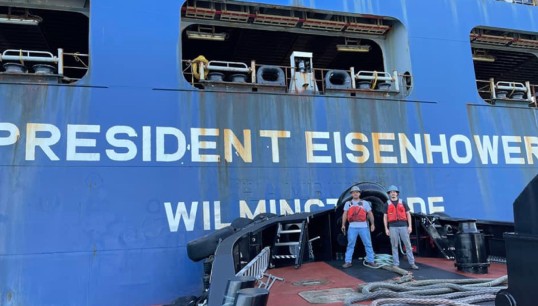Experts call for improved oil leak detection after fire on President Eisenhower containership
15 June 2022

US safety experts have called for improved systems to be fitted to ships to enable rapid detection of oil leaks to prevent fires in machinery spaces.
The call comes after an investigation into an engineroom blaze onboard the 82,794gt containership President Eisenhower in April last year. Although no one was injured, the ship lost propulsion and drifted for several hours before being towed into the port of Los Angeles.
An investigation by the US National Transportation Safety Board (NTSB) found that ultra-low sulphur diesel fuel had begun spraying in the area around the main engine’s no. 5 cylinder about 30 minutes before the fire started and rapidly spread to cardboard and wooden boxes containing spare parts that were being stored next to the auxiliary boiler.
The engineroom was unattended at the time (0154hrs), and the leaking fuel was not noticed until an AB on the bridge wing saw smoke coming from an open hatch. At around the same time, an alarm was triggered indicating that a flame or smoke detector in the engineroom had activated.
The NTSB report praises the ‘textbook perfect’ response of the crew of the US-flagged ship to the fire. They had fought the blaze with fire hoses and a fixed water mist system before activating the CO2 equipment in the engineroom.
‘The crew of the President Eisenhower effectively contained the spread of a main engineroom fire by removing fuel and oxygen sources, cooling boundaries, and communicating effectively,’ it points out. ‘These efforts show the importance of realistic scenario-based training, including engineroom emergencies, which involve shutting down machinery, fuel oil, lube oil, and ventilation systems, as well as boundary monitoring, to quickly contain and suppress engineroom fires, which can spread to other spaces and/or cause a loss of propulsion and electrical power.’
However, the report also notes that the fire could have been avoided if the ship had been fitted with rapid oil leak-detection equipment.
‘Video analytic technology is designed to use standard CCTV video to detect fuel mist and spray in real time and alert the crew before any ignition and fire,’ it points out. ‘This technology is supported by class societies as an acceptable method for identifying leaks and can be integrated with existing CCTV systems. Had this technology been in use aboard the President Eisenhower, the spraying fuel oil may have been detected well before the fire developed.’
Damage to the ship was estimated at US$8.22m and the NTSB said the blaze had probably been the result of the second engineer insufficiently tightening a compression fitting ferrule while repairing fuel oil return tubing for a main engine’s cylinder. When the tubing came apart, the leaking fuel oil eventually ignited on the exposed surface of an unshielded and uninsulated exposed flange for the exhaust valve compensator.
The second engineer told investigators he had not previously carried out such work and said he had difficulties while completing the installation. Although he pressure-tested the system for about an hour afterwards and found no leaks, the NTBS suggested he could have also loosened the compression fitting nut to visually inspect that the ferrule had been successfully swaged to the tubing.
Tags
More articles
Fond farewells for Nautilus Welfare Fund manager after a decade of dedication
Staff and residents at Mariners' Park have paid a fond farewell to its longstanding welfare manager, Mick Howarth.
MNWB: investing in frontline services
Stuart Rivers describes the Merchant Navy Welfare Board (MNWB) as ‘possibly the greatest charity no-one’s ever heard of’, but has big plans to put it on the map. With a background in the tech industry and a mandate to modernise, there could be some changes ahead for constituent members
Italy to allow extended Schengen visas for yacht crew
The Italian parliament has agreed that yacht crew who are not EU residents will be able to apply for a 365-day visa to remain in the Schengen Area, helping to solve an ongoing issue for yacht workers visiting the country.
